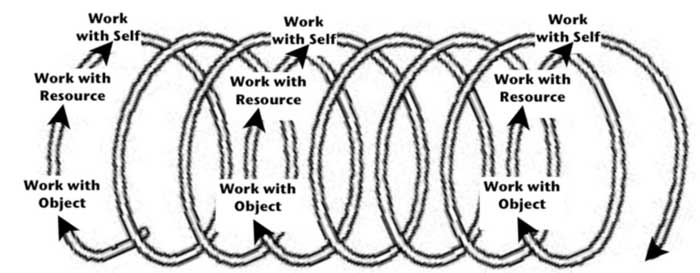Building Scaffolding
Lev Vygtotsky, a Russian born psychologist, has had a significant impact on educational approaches with his theory of learning being a social process. The term, Zone of Proximal Development, which helps teachers identify the sweet spot of challenge for students to gain the most from educational activities grows out of his work.
In mentoring, it is also important for mentors to help mentees identify activities within their Zone of Proximal Development – and then provide the needed resources for them to gain competency. You can see in the graphic below how the ZPD comes between what is too difficult on the left and what a person can already do on the right. (For you Goldilocks fans, you can think of it as the “Baby Bear” zone – where things are not too hard and not too easy, but just right.)
In my experience, I have found activities in the following three steps to be a successful framework.
Step 1: Work with Object
This first step in the process is for someone to work with some task on their own. In doing this, the learner identifies what her challenges are. It helps to cognitively prepare to benefit from seeing the ideas of how another person might address this. So, for mentees, it is important to have them interpret a text or try to explain some topic in ASL before showing them how to do it. If you show them first, they won’t be as focused as if they have to try it and see where their own challenges lie.
Step 2: Work with Resource
This draws on Vygtotsky’s idea that learning is a socially-mediated process. That is, we learn from our interactions with others. Now, as a mentor, your job is to help provide resources to the mentee – not necessarily be the resource. So, the resource might be you asking a series of questions that helps mentees clarify their own decision-making processes. Or it might be identifying another video resource for them to work with – perhaps an ASL model of some text that they can both watch and shadow (sign along with) to gain more insight into how another person might convey those concepts. Finally, it can be you sharing some of your own experience and perspective – but offering a variety of resources can be really important.
Step 3: Work with Self
The final step is for mentees to take what they have gathered from the resources and put it into practice. Re-interpret the text. Try out what works. See what fits with their interpreting style – and what to leave for another day. It is really important to physically do this, rather than just think about what you would do.
With these three processes, it becomes a learning spiral as demonstrated in the diagram below.
In doing this work over and over again, the Zone of Proximal Development for a learner shifts. All of us in our learning still continue to have a ZPD – it is just the amount that we can handle independently grows.
For more on this framework please check out my post outlining my chapter, “Just want the doctor ordered? Online possibilities for healthcare interpreting education,” in Swabey & Malcolm, ed. In Our Hands: Educating Healthcare Interpreters http://gupress.gallaudet.edu/bookpage/IOHbookpage.html
See More on Online Frameworks for Education
Posted in: Mentoring Resources


